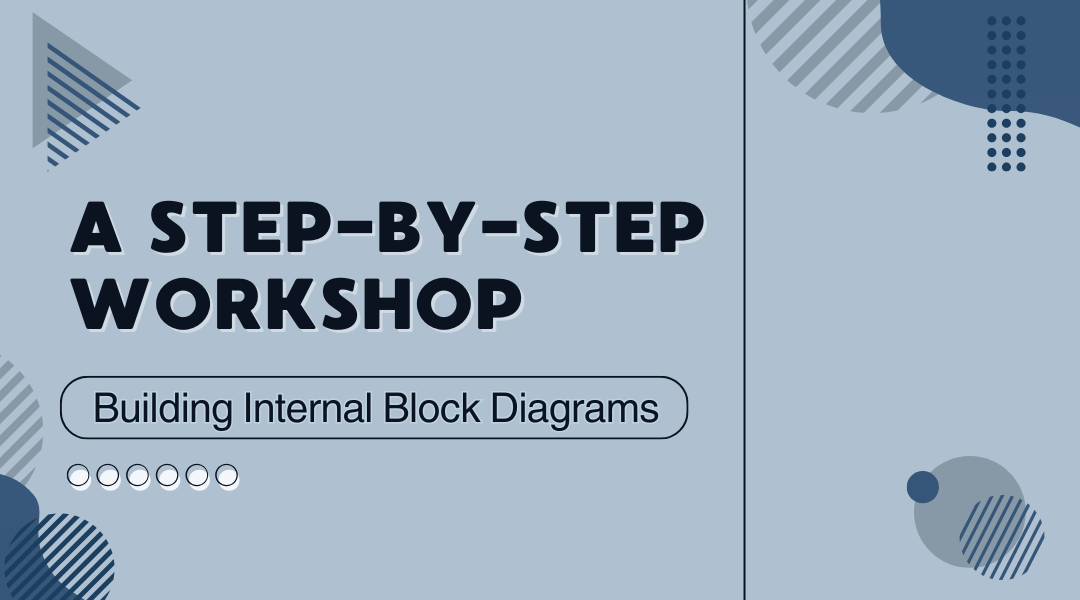Creating an effective Internal Block Diagram (IBD) isn’t about perfect shapes or fancy tools—it’s about capturing how your system really works. I’ll walk you through the process using a smart irrigation system as our case study, showing you exactly how to turn a jumble of components into a crystal-clear diagram.
1. Start With the Nuts and Bolts
First, we need to identify what’s actually inside our system. Forget fancy terminology—just list what physically exists.
Smart Irrigation System Components:
- Soil moisture sensor (the plant’s thirst detector)
- Weather API interface (checks if rain’s coming)
- Valve controller (the water gatekeeper)
- Main control board (the brain)
- User app interface
Pro Tip: Walk through the system’s operation in your head. When the soil gets dry, what talks to what? That’s your diagram starting to form.
2. Draw First, Perfect Later
Grab a whiteboard or scrap paper and sketch boxes for each major component. Don’t overthink it yet—just get them out of your head.
Our Initial Blocks:
1. Moisture Sensor
- Sends Analog Data (e.g., 0–3V signal) → Control Board.
2. Weather API
- Sends JSON Forecast (e.g., rain predictions) → Control Board.
3. Mobile App
- Exchanges User Settings/Status ↔ Control Board (two-way communication).
4. Control Board
- Sends Valve Commands (e.g., “open/close”) → Valve Controller.
Common Mistake: Beginners often create either too many boxes (showing individual resistors) or too few (lumping everything as “electronics”). Aim for functional units.
3. Define the Conversation Points
Every component needs clear ways to communicate. These are your ports—think of them as specialized plug sockets.
Port Examples:
- Moisture Sensor:
- “Data Out” (sends % moisture)
- “Power In” (needs 3.3V)
- Valve Controller:
- “Command In” (open/close orders)
- “Status Out” (confirms action)
Real-World Gotcha: I once saw a design fail because the team forgot the valve controller needed a “fault” output port—when valves jammed, the system froze.
4. Connect the Dots (Literally)
Now draw lines showing actual connections. Be specific about what travels where.
Critical Connections:
- Moisture Sensor → Control Board (Soil data @ 1Hz)
- Weather Service → Control Board (Rain forecast JSON)
- Control Board → Valve Controller (Open/Close commands)
- Control Board ↔ Mobile App (Settings/Status)
Prototyping Insight: These lines should match your actual wiring plan. If you’re using I2C between components, note that on the diagram.
5. Add the Technical Fine Print
Here’s where we go from “pretty picture” to engineering document.
Essential Details to Include:
- Voltage levels (Is that sensor running on 3.3V or 5V?)
- Data protocols (UART, I2C, SPI?)
- Timing requirements (Does moisture data need real-time?)
- Safety interfaces (Emergency shutoff path?)
Example Annotation:
“Moisture Data: Analog 0-3V DC, sampled every 2 seconds ±0.5s”
6. Stress-Test Your Diagram
A good IBD should answer tough questions before they become problems.
Validation Checklist:
✓ Can the control board handle simultaneous inputs?
✓ Is there a clear path for manual override?
✓ Do all power requirements match available supplies?
✓ Are any critical connections missing redundancy?
War Story: A team’s “finished” IBD missed the battery backup interface. When mains power failed, so did their entire system.
7. Iterate Like a Pro
Your first draft will be wrong—and that’s normal. Here’s how to improve:
Revision Tactics:
- Walk through failure scenarios (What if a sensor dies mid-read?)
- Add performance limits (Max 3 valves operating simultaneously)
- Color-code critical paths (Red for safety-critical links)
Pro Move: Use different line styles—solid for power, dashed for data, dotted for diagnostics.
From Diagram to Reality
Let’s see our completed Smart Irrigation IBD in action:
1. Inputs to Control Board
- Moisture Sensor
→ Sends Analog Data (e.g., 0–3V soil moisture readings) to the Control Board.
Example: “Soil at 2.7V (dry)” → Triggers watering. - Weather API
→ Sends JSON Forecast (e.g.,{"rain_expected": true}) to the Control Board.
Example: Skips watering if rain is coming. - Mobile App
↔ Two-way communication with Control Board for User Settings/Status.
Example: User sets “Water at 6 AM” or checks valve status.
2. Control Board Output
Valve Controller
- ← Receives Valve Commands (e.g.,
OPEN_VALVE_3) from the Control Board. - Example: Opens Valve 3 for 5 minutes when soil is dry.
Key Takeaway: Notice how we can instantly see:
- All data flows left-to-right into the control board
- No direct sensor-to-valve link (prevents false triggers)
- Mobile app talks only to the main board
Your Turn: Kitchen Edition
Try modeling a smart coffee maker:
- Water level sensor
- Heating element
- Grinder motor
- Control panel
- WiFi module
Where would you place the over-temperature safety cutoff? (Hint: It should interrupt power directly, not just send a data warning.)
Remember: The best IBDs don’t just describe systems—they prevent tomorrow’s troubleshooting headaches. What system will you diagram first?
